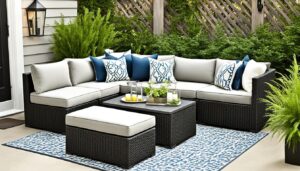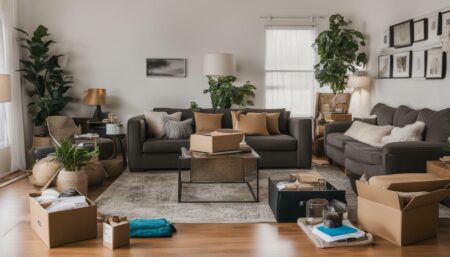Organizing your house can be a daunting task, filled with challenges and obstacles that can leave even the most organized individuals feeling overwhelmed. There are several reasons why this process can be so difficult.
One of the main challenges is having too much stuff. Many people accumulate belongings over time, and this excess can make it hard to find space to organize effectively. Clutter takes up valuable real estate in our homes, leaving little room for efficient organization.
Another hurdle is the ongoing battle with clutter. It’s not enough to simply tidy up once and expect things to stay organized. Maintaining an organized home requires consistent effort and systems that can withstand the daily challenges of clutter.
Not only does clutter make it hard to find things, but it also comes with a financial cost. Buying, storing, and organizing excessive belongings can strain our finances. Addressing clutter and creating sustainable organization systems can help alleviate this burden.
Moreover, it’s important to shift our focus from just organizing stuff to creating a home environment that aligns with our dreams and goals. By organizing with purpose, we can create a space that supports and inspires us in various aspects of our lives.
Personal factors can also make organizing a challenge. Some people may not know where to start or feel overwhelmed by the task at hand. Mental alertness and the ability to stay focused can also impact our ability to organize effectively. Additionally, some individuals may struggle with hoarding tendencies, which further complicates the organizing process.
Despite these challenges, there are solutions and tips to help you overcome them. Throughout this article, we will explore practical strategies for home organization, offer helpful tips, and provide guidance on how to navigate the common obstacles.
- Having too much stuff can make it hard to find space for organization.
- Clutter requires ongoing effort to maintain an organized home.
- Clutter comes with a financial cost in terms of purchasing, storing, and organizing belongings.
- Organizing with purpose can help create a home that aligns with your dreams and goals.
- Personal factors like feeling overwhelmed or being a hoarder can pose challenges in organizing.
Too much stuff: The struggle to find space
One of the biggest challenges in home organization is the sheer amount of belongings that accumulate over time, resulting in a struggle to find sufficient space for everything. Many people find themselves dealing with an excess of stuff, whether it’s clothes, books, or miscellaneous items that have accumulated over the years. This can make it difficult to find a place for everything, leading to a cluttered and disorganized living space.
Organizing small spaces can be particularly challenging, as it requires creative thinking to maximize storage capacity. When space is limited, every inch counts. It’s essential to declutter and prioritize belongings, keeping only what is truly necessary or meaningful. One effective strategy is to utilize storage solutions that optimize vertical space, such as wall shelves or hanging organizers. By thinking vertically, you can free up valuable floor space and create a more organized environment.
To tackle the struggle of finding space, it’s important to evaluate your belongings and let go of items that no longer serve a purpose or bring you joy. Decluttering can be a daunting task, but breaking it down into smaller, manageable steps can make it more achievable. Start with one room or area at a time, sorting items into categories: keep, donate, or discard. By systematically going through your belongings, you can make more informed decisions about what to keep and how to best organize it.
| Decluttering Tips: |
|---|
| Start with small areas like closets or drawers to build momentum. |
| Set specific goals and timelines to keep yourself motivated. |
| Consider storage solutions that maximize vertical space. |
| Use clear containers or labels to easily identify and access stored items. |
By addressing the challenge of too much stuff and implementing effective decluttering strategies, you can create a more organized and functional living space. Remember, organizing is an ongoing process, so it’s important to develop habits that help you maintain your newfound order.
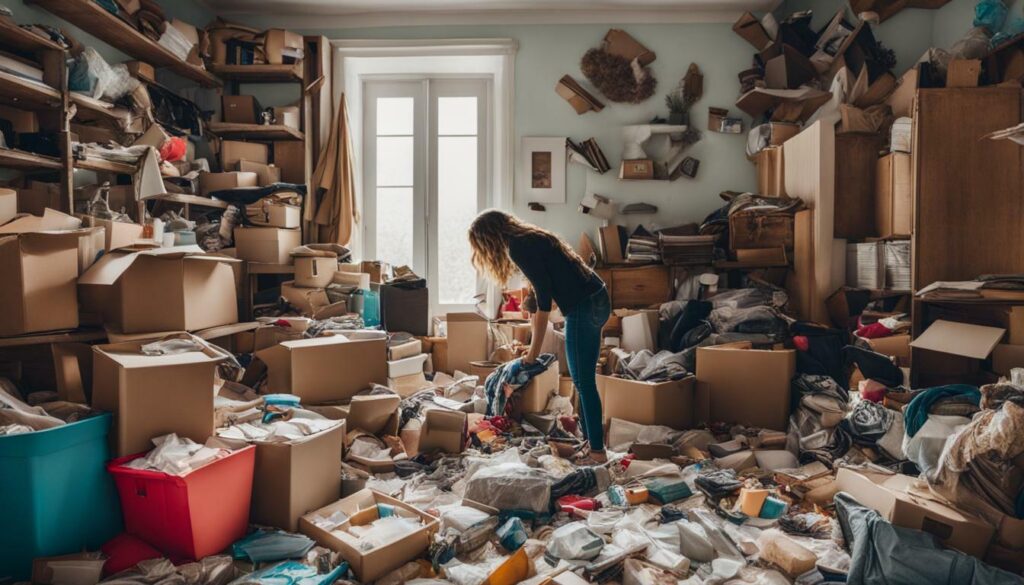
Once you’ve managed to declutter and organize your home, the battle isn’t over, as the ongoing challenge of maintaining an organized space presents itself. Clutter has a way of creeping back into our lives, and without consistent effort, it can quickly undo all our hard work. The key to overcoming this challenge is to establish effective habits and systems that will help you stay on top of clutter.
One strategy to maintain an organized home is to set aside a few minutes each day for tidying up. By dedicating a small amount of time to decluttering and organizing, you can prevent clutter from accumulating and becoming overwhelming. This could involve returning items to their designated storage spaces, putting away dishes immediately after use, or clearing out any unnecessary paperwork.
Another helpful approach is to create designated homes for your belongings. By assigning specific places for items, you can easily find and put things away, reducing the likelihood of clutter accumulating. Consider using storage containers, bins, and labels to help keep everything organized and visually appealing. Additionally, regularly reassess your belongings to identify items that are no longer needed or used, and consider donating or selling them.
Maintaining an organized home: Tips and strategies
- Establish a daily decluttering routine to prevent clutter from building up.
- Create designated homes for your belongings to make organization easier.
- Use storage containers, bins, and labels to keep items organized.
- Regularly reassess your belongings and let go of items you no longer use or need.
- Involve your family in the organization process to create a shared responsibility.
By implementing these strategies and maintaining a proactive mindset, you can overcome the ongoing battle with clutter and enjoy the benefits of an organized home. Remember, organizing is an ongoing process, and it’s important to prioritize consistency and persistence. With time and effort, you can create a living space that is both functional and aesthetically pleasing.
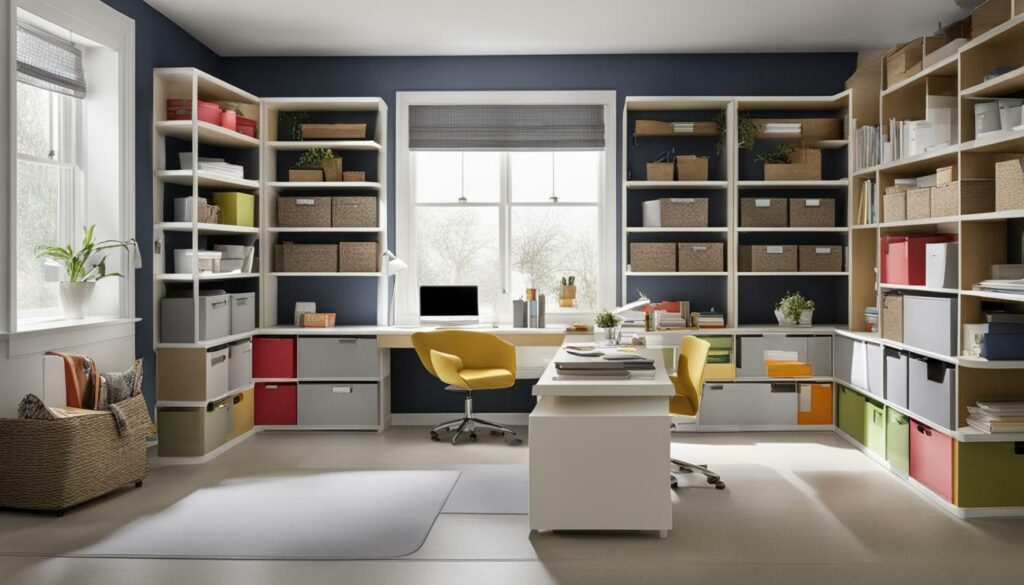
The cost of clutter
Clutter not only occupies physical space but also takes a toll on your wallet, resulting in unnecessary expenses for purchasing, storing, and organizing items. When our homes are overrun by clutter, it becomes difficult to find what we need, leading to duplicate purchases and wasted money. How many times have you bought something, only to later discover that you already had a similar item buried in a mess? This lack of organization can also lead to damaged or forgotten items, resulting in additional expenses to replace them.
Additionally, storing and maintaining clutter requires extra space and resources. We may find ourselves renting storage units or investing in larger homes with more storage options, all of which come at a significant cost. The more belongings we accumulate, the more space and storage solutions we need to manage them, driving up our housing expenses.
Furthermore, the time and effort required to organize the chaos can also have financial implications. Think about the hours spent searching for misplaced items or cleaning up cluttered spaces. Time spent on these activities could have been invested in more productive endeavors, such as pursuing hobbies or working on personal or professional growth. By decluttering and organizing our homes, we can reclaim valuable time and redirect our focus towards activities that bring us joy and contribute to our financial well-being.
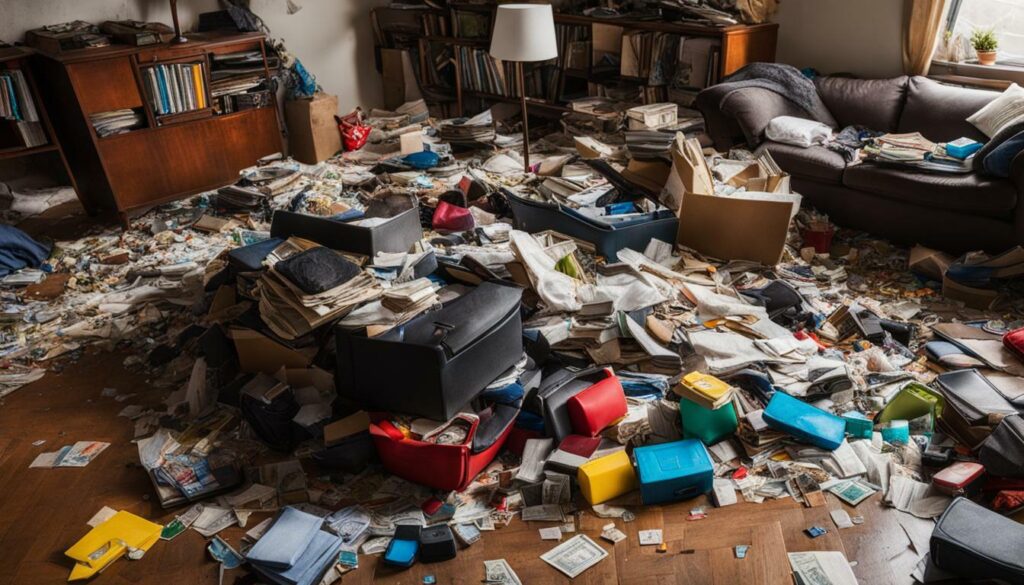
| Expense | Estimated Cost |
|---|---|
| Duplicate purchases | $500+ |
| Storage solutions | $1000+ |
| Replacement of lost or damaged items | $300+ |
| Wasted time searching for items | 10+ hours per month |
As you can see, the cost of clutter can quickly add up, causing financial strain and reducing our overall quality of life. By recognizing the financial impact of clutter, we can be motivated to take action and begin the journey towards a more organized and cost-effective lifestyle.
Creating a Home That Serves Your Dreams and Goals
Instead of solely focusing on clutter and organization, it is essential to create a home that reflects and supports your aspirations and ambitions. Effective home organizing strategies go beyond simply tidying up; they involve creating an environment that aligns with your lifestyle and goals.
One strategy is to identify your priorities and values. Consider what matters most to you in life and how your home can support those aspirations. If you dream of being a writer, create a dedicated writing space that inspires creativity. If fitness is important, carve out a small corner for workout equipment or designate an area for yoga and meditation.
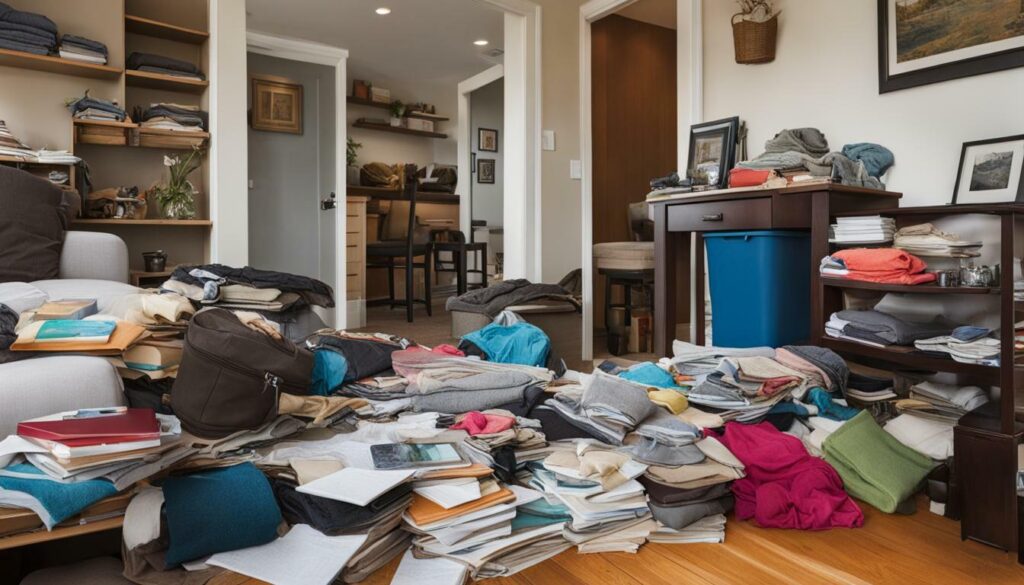
Another strategy is to declutter with purpose. Let go of items that no longer serve you or bring you joy. Marie Kondo’s famous question, “Does it spark joy?” can guide you in making decluttering decisions. Surround yourself with possessions that have meaning and contribute to your vision for the future.
Finally, establish systems and routines that support your organization goals. Create a schedule for regular tidying and cleaning to prevent clutter from accumulating. Incorporate habits that promote organization, such as putting things away after each use or designating specific storage areas for different items. By integrating these strategies into your daily life, you can create a home that serves as a sanctuary and a reflection of who you are and what you aspire to be.
Overcoming Personal Barriers to Organization
Beyond external factors, personal barriers such as not knowing how to organize or feeling overwhelmed can pose significant challenges to achieving an organized home. However, with the right mindset and strategies, it is possible to overcome these barriers and create a space that is both functional and aesthetically pleasing.
One common barrier is not knowing how to organize. This can lead to a sense of confusion and frustration, making it difficult to know where to start. The key is to educate yourself on effective organizing techniques. There are numerous resources available, such as books, online articles, and professional organizers, that can provide guidance and inspiration.
Feeling overwhelmed is another personal barrier that many people face. It’s important to break the organizing process down into smaller, more manageable tasks. Start with one area or room at a time and set realistic goals. Celebrate each small accomplishment, as this will help to build momentum and motivation.

Being mentally alert is essential for effective organization. Clearing mental clutter and creating a focused mindset can greatly enhance productivity. Prioritize tasks, eliminate distractions, and create a peaceful environment to help maintain mental clarity.
For those who struggle with being easily distracted, creating a dedicated work or organizing space can help. This space should be free from distractions and set up in a way that promotes focus and productivity. Consider using tools such as noise-cancelling headphones, timers, or task management apps to stay on track.
Lastly, being a hoarder can make organization particularly challenging. Hoarding is a complex issue that often requires professional intervention. Seeking therapy or support groups can help address the underlying causes of hoarding behavior and provide tools for managing possessions in a healthier way.
Tips for Decluttering Chaos
Decluttering chaos is the first step towards a more organized home, and with the right strategies and techniques, it is a task that can be tackled successfully. Whether you’re dealing with a cluttered closet, a messy kitchen, or an overwhelmed storage space, these home organization tips will help you regain control and create a more harmonious living environment.
1. Start Small
When faced with a cluttered space, it can be overwhelming to know where to begin. Start by selecting a small area or category, such as a single drawer or a pile of papers, and focus on decluttering and organizing that specific area before moving on to the next. Breaking the task down into smaller, manageable chunks will make it feel less daunting and more achievable.
2. Sort and Categorize
Before diving into the decluttering process, create designated piles or bins for different categories, such as “Keep,” “Donate,” “Sell,” and “Trash.” As you go through your belongings, be honest with yourself about what you truly need and love, and let go of items that no longer serve a purpose or bring you joy. Sorting and categorizing your belongings will help you make better decisions and create a clear vision of what you want to keep and what can be let go.
3. Create Functional Systems
Once you have decluttered and sorted your belongings, it’s essential to create functional systems that will help you maintain an organized home in the long run. Invest in storage solutions such as bins, baskets, and shelves to maximize space and keep items easily accessible. Labeling containers and assigning specific areas for different categories will make it easier to find and put away items, ensuring that clutter doesn’t creep back into your home.
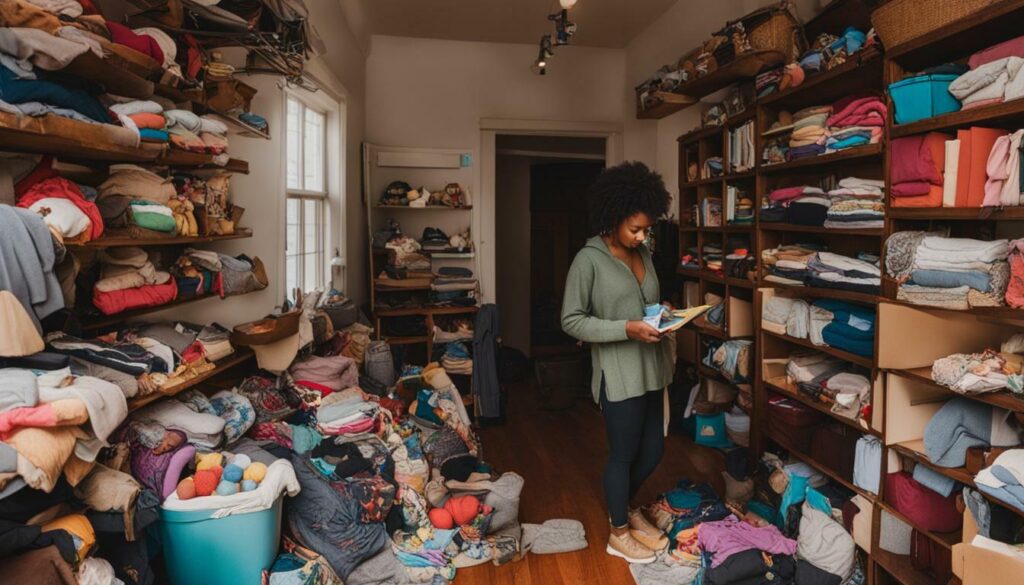
Remember, decluttering is an ongoing process, and it’s important to regularly reassess your possessions and make adjustments as needed. By implementing these home organization tips and tackling the chaos one step at a time, you’ll create a more serene and functional living space that reflects your goals and aspirations.
Simplifying Storage in Small Spaces
Living in a small space doesn’t mean sacrificing organization; rather, it requires innovative solutions to simplify storage and optimize every inch of available space. Whether you live in a cozy apartment or a compact house, there are numerous ways to make the most of your limited square footage. By implementing smart storage solutions, you can create a clutter-free environment that maximizes functionality and minimizes stress.
One effective strategy is to utilize multi-purpose furniture that offers hidden storage compartments. For example, a coffee table with built-in drawers or ottomans with lift-up tops can provide valuable space to stow away items like blankets, magazines, or toys. Additionally, vertical storage is key when organizing small spaces. Consider installing shelves or wall-mounted storage units to take advantage of wall space, keeping floors clear and creating a visually appealing display.
Another ingenious way to organize small spaces is through the use of storage containers and dividers. These can be utilized in drawers, cabinets, or even under the bed, allowing you to categorize and easily access your belongings. Clear plastic bins or woven baskets not only add visual appeal but also make it simple to identify the contents without rummaging through clutter.
| Storage Solution | Description |
|---|---|
| Hanging Shoe Organizers | Maximize vertical space by using hanging shoe organizers on the back of doors or inside closets. They can hold more than just shoes! Use them to store accessories, cleaning supplies, or small items like socks and scarves. |
| Door-Mounted Racks | Utilize the often-overlooked space behind doors by adding door-mounted racks. These versatile organizers are perfect for holding items such as towels, bags, or even pantry staples like spices and snacks. |
| Under-Bed Storage | Make the most of the space under your bed by utilizing storage boxes or bins specifically designed for this purpose. Store seasonal clothing, extra bedding, or even out-of-season sports equipment to free up valuable closet space. |
Creating an organized and functional home in a small space requires thinking outside the box and embracing creative solutions. By implementing these storage ideas and adopting a minimalist mindset, you can transform your small space into a well-organized sanctuary that reflects your unique style and maximizes functionality.
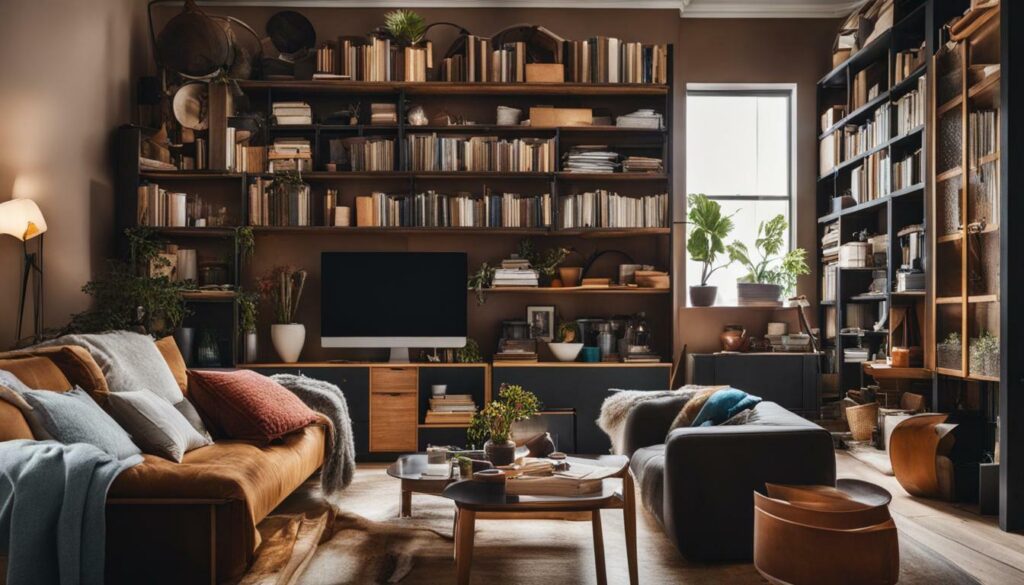
Once you have achieved an organized home, the key to sustaining it lies in adopting effective strategies and routines to maintain order. It’s important to establish habits that will help you stay organized and prevent clutter from creeping back into your space. Here are some strategies and tips for maintaining an organized home:
- Create a daily cleaning routine: Set aside a specific time each day to tidy up and put things back in their designated places. This can be as simple as spending 15 minutes each morning or evening to do a quick sweep of your home. By incorporating cleaning into your daily routine, you’ll prevent clutter from accumulating and keep your home looking neat and organized.
- Regular decluttering: Make decluttering a regular practice in your home. Set aside time every few months to go through your belongings and purge items you no longer need or use. This will help prevent clutter from building up and ensure that your space remains organized and functional.
- Assign a home for everything: Give every item in your home a designated place where it belongs. This will make it easier to put things away and find them when you need them. Be sure to communicate these designated spots to other members of your household so that everyone is on the same page.
- Utilize storage solutions: Invest in storage solutions that help maximize your space and keep things organized. Utilize bins, baskets, shelves, and drawer organizers to keep items sorted and easily accessible. This will make it easier to maintain order in your home.
By implementing these strategies and making them a part of your daily routine, you’ll be able to maintain an organized home that feels calm and clutter-free. Remember, consistency is key, so stick to your routines and be mindful of bringing new items into your space. With a little effort and commitment, you can enjoy the benefits of an organized home for years to come.
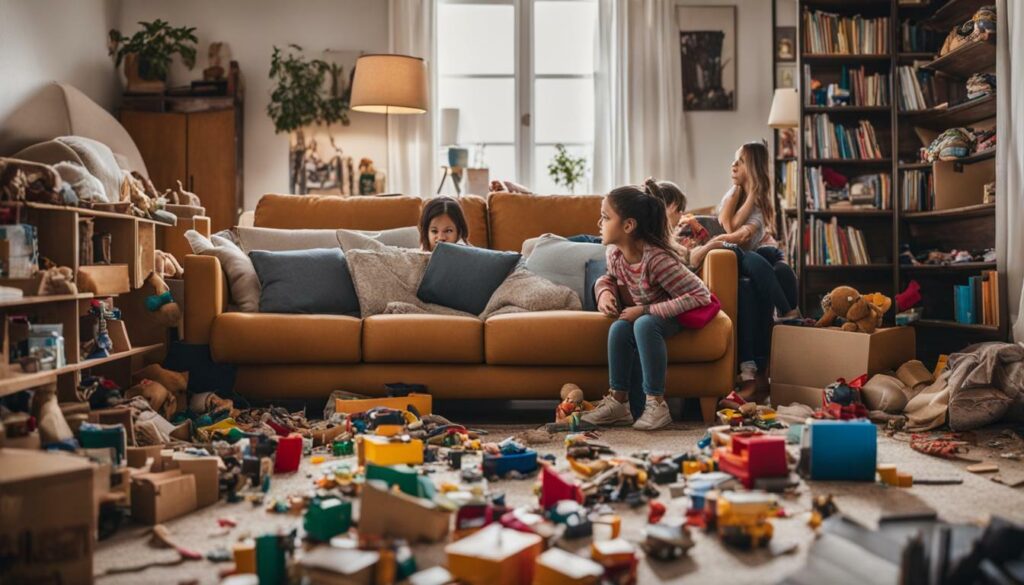
| Benefits of Maintaining an Organized Home | Strategies for Maintaining an Organized Home |
|---|---|
|
|
Overcoming Clutter and Disorganization
Overcoming clutter and disorganization requires a combination of mindset changes and practical actions to regain control of your space. It’s not just about tidying up; it’s about creating a functional and harmonious environment that supports your goals and aspirations. Here are some effective home organization solutions to help you on your journey:
- Start with a plan: Take the time to assess your space and identify the areas that need the most attention. Prioritize tasks and create a realistic timeline to avoid feeling overwhelmed.
- Declutter ruthlessly: Begin by sorting through your belongings and letting go of items that no longer serve a purpose or bring you joy. Consider donating, selling, or recycling them.
- Create dedicated storage solutions: Invest in storage containers, shelves, and organizers that suit your specific needs. Categorize items and assign them designated spaces to make it easier to find and put things away.
- Develop daily habits: Incorporate simple habits into your routine, such as putting things back in their designated places, dealing with incoming mail immediately, and doing a quick declutter before going to bed.
- Seek professional help: If you’re feeling overwhelmed or struggling with hoarding tendencies, don’t hesitate to reach out to a professional organizer or therapist who specializes in clutter and organization.
Quote:
“Organizing is a journey, not a destination. Embrace the process and celebrate every small victory along the way.” – Unknown
Remember, organizing your home is a continuous effort. It’s about creating a space that supports your lifestyle and brings you peace of mind. By implementing these home organization solutions, you can overcome clutter and disorganization, paving the way for a more organized and fulfilling life.
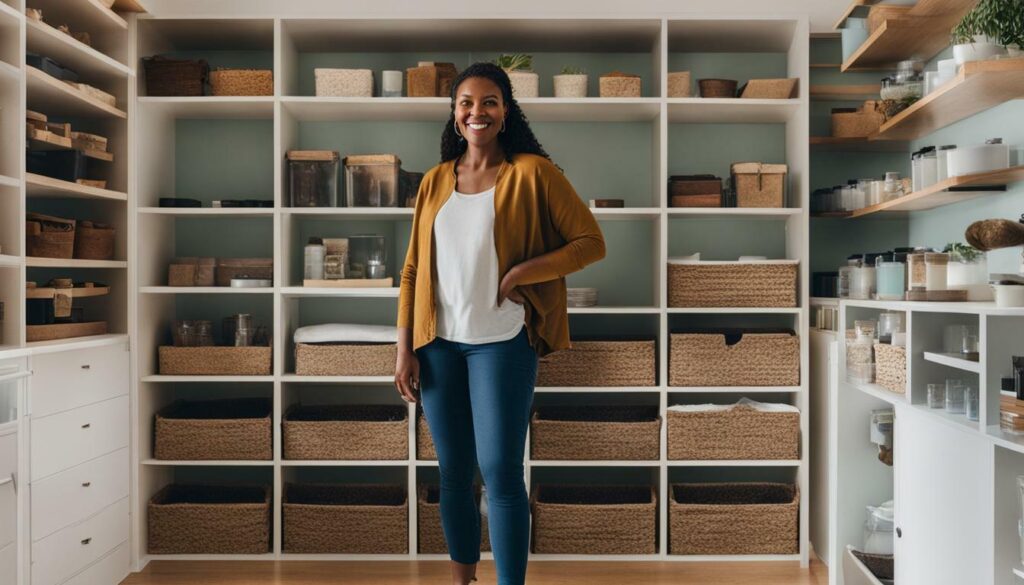
| Benefits of Overcoming Clutter and Disorganization |
|---|
| 1. Reduced stress and anxiety |
| 2. Increased productivity and focus |
| 3. More time and energy for activities you enjoy |
| 4. Enhanced visual appeal and comfort of your space |
| 5. Improved financial management |
Organizing Household Items Like a Pro
Professional organization techniques can transform the way you manage and maintain your household items, creating a more functional and visually appealing space. When it comes to organizing household items, there are several strategies you can employ to make the process easier and more efficient.
One effective method is to categorize your items. Create designated areas for different types of items, such as kitchen utensils, cleaning supplies, or clothing. This will not only help you locate things more quickly but also prevent clutter from accumulating in one area.
Another useful tip is to invest in storage solutions that maximize space and efficiency. Use clear bins or baskets to group similar items together and make them easily accessible. Consider utilizing vertical space by installing shelves or utilizing wall-mounted organizers to keep items off countertops and floors.
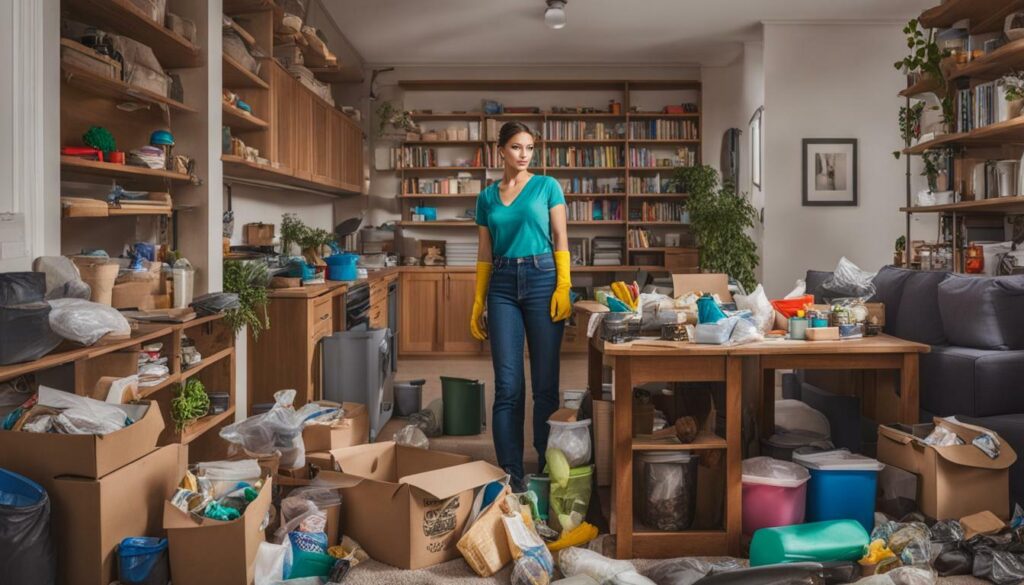
Furthermore, labeling is crucial for maintaining an organized home. Labeling containers, shelves, and drawers can help you quickly identify where items belong and make it easier to put things back in their proper place. This simple step can save you time and prevent items from getting misplaced.
| Benefits of Professional Organization Techniques: | Key Takeaways: |
|---|---|
| Enhanced functionality | Create designated areas for different items |
| Improved visual appeal | Invest in storage solutions to maximize space |
| Time savings | Utilize vertical space and wall-mounted organizers |
| Reduced stress | Label containers, shelves, and drawers |
By implementing these professional organization techniques, you can transform your household items from a source of stress and clutter into a well-organized, visually appealing space that supports your daily routines and goals.
Remember, organizing is an ongoing process, so be sure to regularly assess and declutter your belongings to maintain a harmonious and functional home environment.
Conclusion
Overcoming the challenges of home organization may seem daunting, but with the right strategies and mindset, you can transform your space into a sanctuary of order and tranquility. One of the key difficulties many face is having too much stuff, which can make it hard to find sufficient space for organization. By decluttering and optimizing storage in small spaces, you can create more room and make organization easier.
Maintaining an organized home requires consistent effort, as clutter has a way of creeping back in. However, the benefits of a tidy space far outweigh the challenges. Clutter not only consumes physical space but also costs money, with the expenses of purchasing, storing, and organizing excessive belongings. By focusing on creating a home that aligns with your dreams and goals, you can shift your perspective and approach to organization.
Personal barriers, such as not knowing how to organize, feeling overwhelmed, having difficulty staying mentally alert, being easily distracted, or struggling with hoarding tendencies, can also impede the organization process. By addressing these obstacles head-on and adopting effective strategies, you can overcome these challenges and create the organized home you desire.
To start decluttering chaos, it’s essential to have practical tips and actionable steps at your disposal. By following these tips and approaching decluttering in an organized manner, you can make the process more manageable and efficient. Additionally, simplifying storage in small spaces is crucial to maximizing your available space and creating functional systems that work for you.
Consistency is key to maintaining an organized home. By developing habits and strategies that suit your lifestyle, you can sustain your organized space in the long term. Finally, by implementing effective solutions for overcoming clutter and disorganization, such as mindset shifts and daily habits, you can create a clutter-free environment that brings ease and peace to your daily life.

